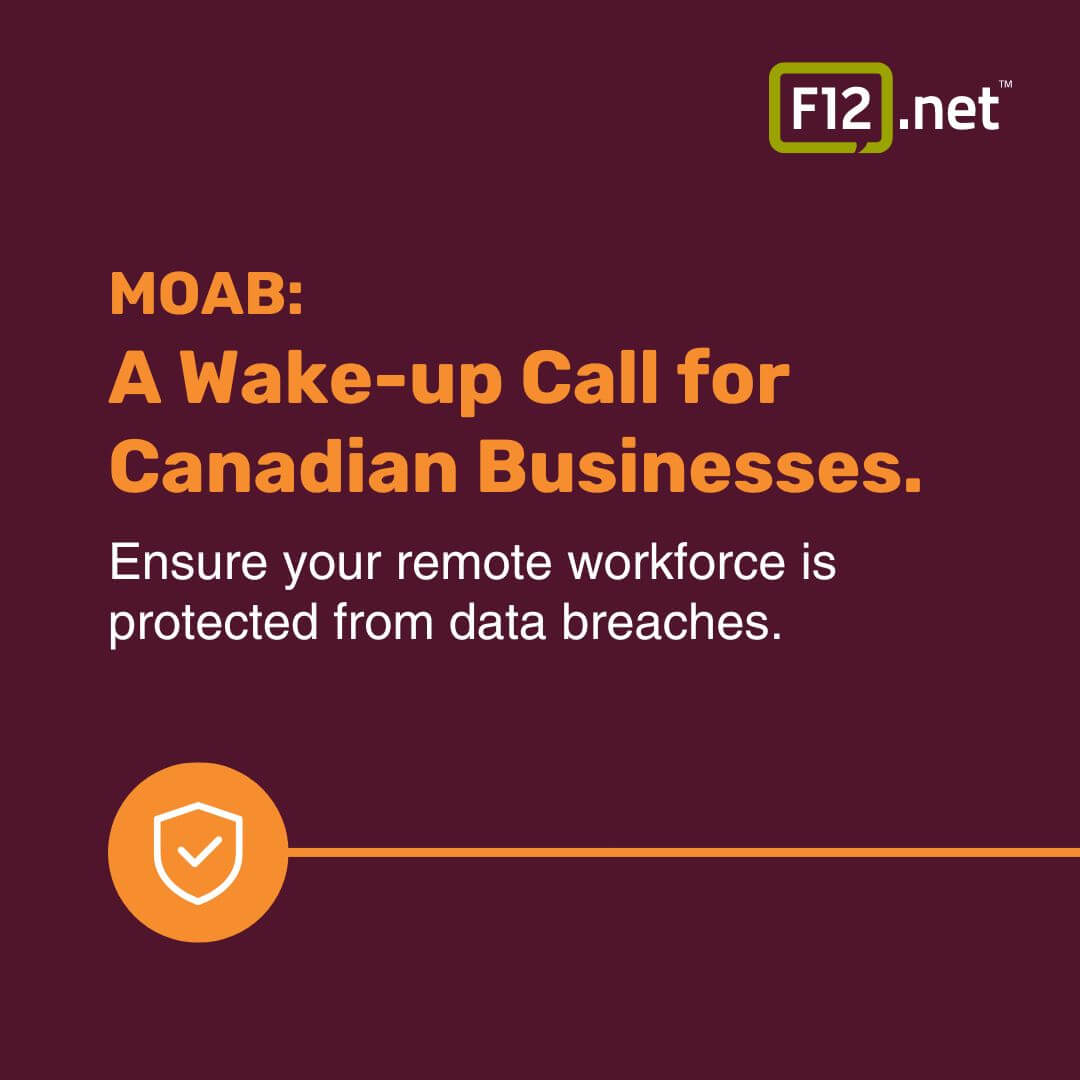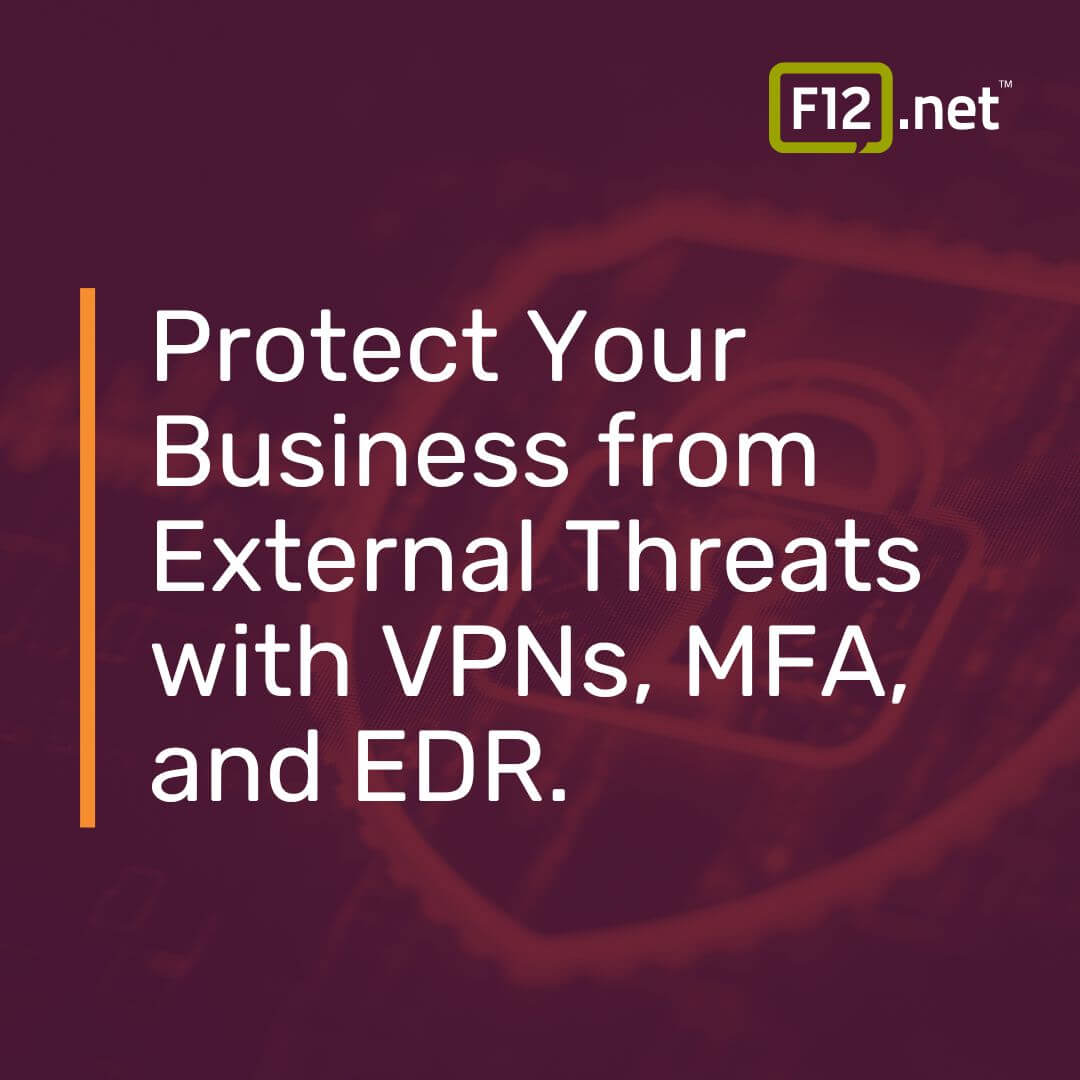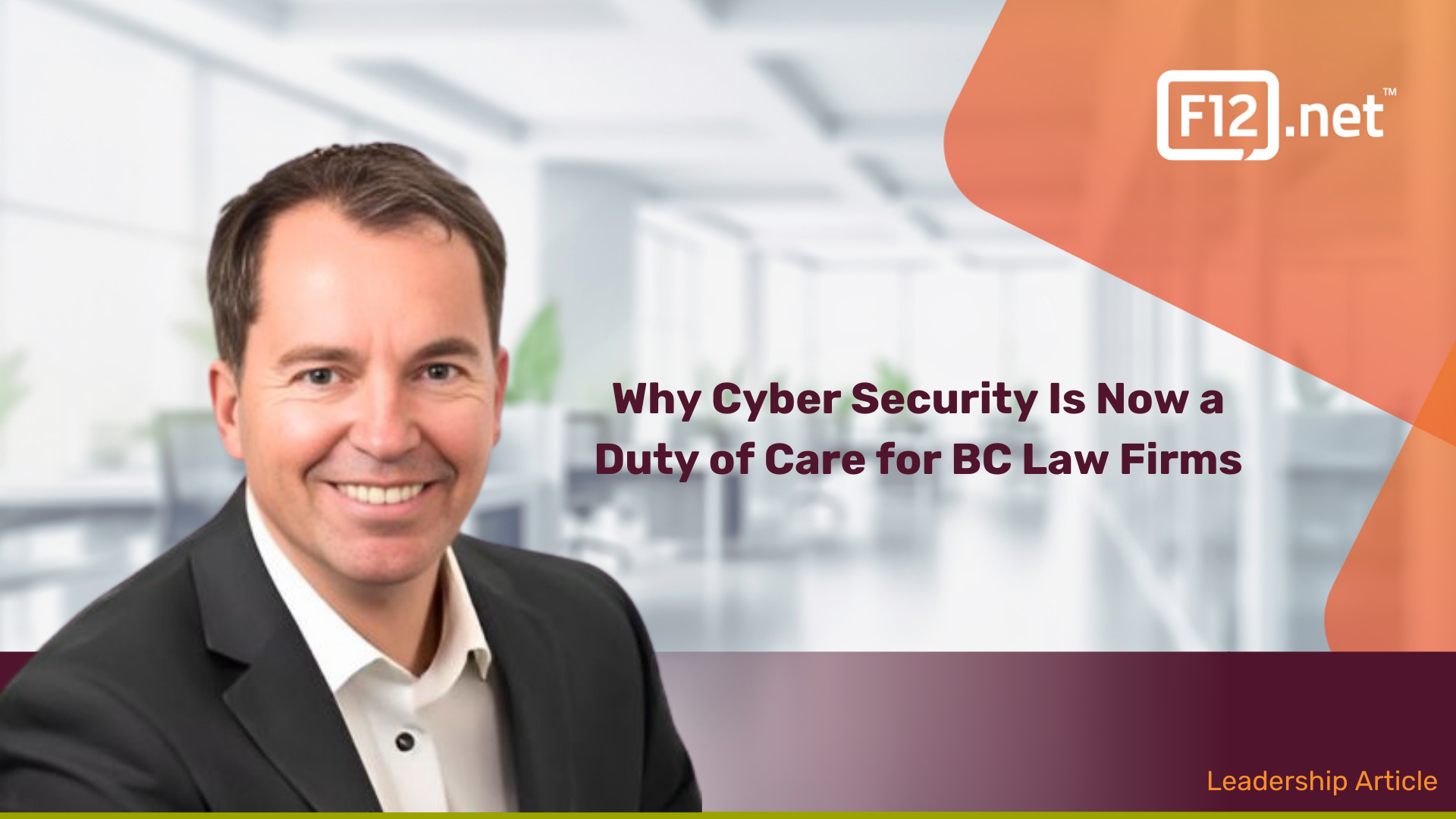Brief: In this article, we break down the essential components of remote workforce security, from implementing secure remote access protocols to strengthening identity and access management, we’ll cover the key technologies and best practices you need to know.
How to Secure Your Remote Workforce in 2024
“We are not alone.”
— Roy Neary, Close Encounters of the Third Kind
Since 2020 our work environment has expanded beyond the traditional office walls.
Similar to earthlings in Close Encounters, in-office workers are no longer alone.
Many businesses in Canada now operate in a more connected and complex ecosystem that include remote and hybrid workers.
And while remote workers are not an existential threat, they do present your business with unique cyber security challenges.
For example…
MOAB (Mother of All Breaches) is a wake-up call for Canadian businesses with a hybrid or remote workforce.
Why?
The breach involved the exposure of a massive amount of personal and corporate data to the dark web.
This can happen due to vulnerabilities in remote workforce security practices, especially those that can be exploited remotely like weaknesses in remote access protocols, unsecured databases, or compromised credentials.
This is important to your business because…
With a remote workforce, your employees are accessing corporate networks and data from various locations and devices.
Each remote connection is a potential entry point for attackers.
If these connections are not properly secured, they can be exploited.

But with so many different devices, platforms, and technologies, where do you start developing a remote workforce security plan?
This step-by-step guide breaks down the essential components of remote workforce security, from implementing secure remote access protocols to strengthening identity and access management.
We’ll cover the key remote workforce security technologies and best practices you need to know, including:
- Virtual Private Networks (VPNs)
- Multi-Factor Authentication (MFA)
- Endpoint Detection and Response (EDR)
Whether you’re a small business owner or an IT professional tasked with securing a large remote workforce, this guide will provide you with the practical knowledge and actionable steps to keep your remote team safe and secure.
Step-by-Step Guide to Implementing Remote Access Security
TL;DR:
- Establish secure remote access protocols with VPNs and MFA
- Regularly monitor and audit remote access activities
- Continuously update and patch remote access systems
Establish Secure Remote Access Protocols
The first step in developing a remote workforce security program is to define and document clear remote access policies. These policies should outline who is allowed to access company resources remotely, what devices and networks they can use, and what security measures they must follow. For example, a comprehensive checklist for remote workers can include measures such as encrypting devices and using supported versions of software.
Next, implement Virtual Private Networks (VPNs) for all remote access. VPNs create an encrypted tunnel between the remote user’s device and the company network, protecting data from interception. Choose a reputable VPN provider and configure it to require strong authentication. This is especially important when accessing public or untrusted networks, as it helps prevent unauthorized access to company data.
Implement Multi-Factor Authentication (MFA)
Multi-Factor Authentication (MFA) adds an extra layer of security to remote access. In addition to a password, users must provide a second form of identification, such as a code from a mobile app or a fingerprint scan. Implement MFA for all remote access, including VPN connections and access to critical applications. This can significantly reduce the risk of unauthorized access.
Regularly Monitor and Audit Remote Access
Implementing secure remote access protocols is not enough – you must also regularly monitor and audit remote access activities. Implement logging and monitoring systems that track who is accessing company resources remotely, when they are accessing them, and what actions they are taking. This can help identify any suspicious activities or security gaps.
Conduct regular audits of remote access logs to identify any suspicious activities or security gaps. Look for unusual login times, failed authentication attempts, or access from unexpected locations. Investigate any anomalies and take appropriate action, such as revoking access or strengthening security measures. Regular training can also help reinforce common security best practices organization-wide.
Keep Remote Access Systems Up-to-Date
Remote access systems, like any software, can have vulnerabilities that attackers can exploit. To stay ahead of threats, continuously update and patch your remote access systems. This includes VPN software, authentication systems, and any applications accessed remotely. Establish a regular schedule for applying updates and patches, and automate the process where possible. Also, ensure that remote users are updating their devices and software regularly. Consider implementing policies that require updates before allowing remote access.
By following these steps – establishing secure protocols, monitoring and auditing access, and keeping systems up-to-date – you can significantly reduce the risk of unauthorized access and data breaches from remote workers. Remember, security is an ongoing process, not a one-time event. Stay vigilant and adapt your remote access security measures as threats evolve.
Ensuring Endpoint Security for Remote Workers
TL;DR:
- Deploy EDR solutions to monitor and protect remote devices
- Implement device management policies and enforce security standards
- Regularly update security measures and educate employees on best practices
Deploy Endpoint Detection and Response (EDR) Solutions
Endpoint Detection and Response (EDR) solutions are critical for securing remote endpoints. EDR tools continuously monitor devices for suspicious activities, detect threats in real-time, and enable quick response to minimize damage. When implementing EDR for your remote workforce:
Implement EDR to monitor and protect remote endpoints
Choose an EDR solution that fits your organization’s needs and deploy it on all remote devices. Ensure that the EDR agent is installed and properly configured on each endpoint. This allows the EDR to monitor device activities, detect anomalies, and collect data for analysis.
Configure EDR to Detect and Respond to Threats in Real-Time
Set up your EDR to identify and alert on potential threats, such as malware, unauthorized access attempts, and data exfiltration. Configure automated response actions, like quarantining infected devices or blocking malicious traffic, to contain threats quickly. Establish clear incident response workflows for your security team to investigate and remediate issues promptly.
Regularly Update EDR Signatures and Policies
Keep your EDR solution up-to-date with the latest threat intelligence and signatures. Regularly review and adjust EDR policies based on evolving risks and your organization’s security requirements. Conduct periodic assessments to ensure that the EDR is effectively protecting your remote endpoints and providing visibility into potential security incidents.
Implement Device Management and Security Policies
To maintain control over remote devices and protect company data, it’s essential to establish clear device management and security policies. This ensures that remote workers follow best practices and maintain a secure working environment. Key steps include:
Establish Device Management Policies for Remote Workers
Define policies for the use of company-owned and personal devices (BYOD) for work purposes. Specify allowed device types, operating systems, and applications. Require remote workers to keep their devices updated with the latest security patches and software versions. Implement a mobile device management (MDM) solution to enforce policies, remotely configure devices, and monitor compliance.
Enforce Device Encryption and Secure Configuration Standards
Mandate full-disk encryption on all devices used for work, protecting data at rest. Provide instructions and support for enabling encryption on different device types. Establish secure configuration baselines, including strong password requirements, screen lock timeouts, and disabling unnecessary services. Regularly audit device configurations to ensure adherence to security standards.
Implement Remote Wipe Capabilities for Lost or Stolen Devices
In case a remote device is lost or stolen, have the ability to remotely wipe corporate data from the device. This minimizes the risk of unauthorized access to sensitive information. Implement remote wipe capabilities through your MDM solution, and ensure that remote workers understand the process for reporting lost or stolen devices promptly.
By deploying EDR solutions and implementing robust device management and security policies, you can significantly enhance the security of your remote workforce endpoints. These measures help protect company data, detect and respond to threats, and maintain a secure remote workforce.
Strengthening Identity and Access Management for Remote Workforce
- Implement strong multi-factor authentication and role-based access control
- Regularly review and update user access rights and permissions
- Monitor user activity and investigate suspicious behavior
As remote work continues to be the norm, securing your workforce’s access to company resources is crucial. Identity and Access Management (IAM) plays a vital role in ensuring that only authorized users can access sensitive data and systems. Let’s explore the steps you can take to strengthen your IAM strategy for your remote workforce.
Implement Strong Multi-Factor Authentication (MFA)
Multi-Factor Authentication adds an extra layer of security beyond usernames and passwords. By requiring users to provide additional verification factors, such as hardware tokens or biometric data, you can significantly reduce the risk of unauthorized access.
Enforce MFA for all Remote Access and Critical Applications
Make sure that all remote access points, such as VPNs and remote desktop solutions, require MFA. Additionally, enforce MFA for all critical applications, such as email, collaboration tools, and sensitive databases.
Use a Combination of Factors
Implement a combination of authentication factors to enhance security. This can include:
- Something the user knows (e.g., password, PIN)
- Something the user has (e.g., hardware token, mobile app)
- Something the user is (e.g., fingerprint, facial recognition)
Using multiple factors makes it much harder for attackers to compromise user accounts.
Regularly Review and Update MFA Policies and Configurations
As new threats emerge and technologies evolve, it’s essential to regularly review and update your MFA policies and configurations. Stay informed about best practices and consider adopting new authentication methods as they become available.
Establish Role-Based Access Control (RBAC)
Role-Based Access Control is a security model that grants users access to resources based on their job functions and responsibilities. By implementing RBAC, you can ensure that users only have access to the information and systems they need to perform their tasks.
Define User Roles and Permissions Based on Job Functions
Start by identifying the different roles within your organization and the permissions each role requires. For example, a sales representative may need access to the CRM system but not to the company’s financial records.
Implement Least Privilege Access Principles
The principle of least privilege states that users should only have the minimum level of access necessary to perform their job duties. By granting users the least amount of privilege possible, you can minimize the potential impact of a compromised account.
Regularly Review and Update User Access Rights
As employees change roles or leave the company, it’s crucial to update their access rights accordingly. Conduct regular access reviews to ensure that user permissions align with their current responsibilities and revoke access for terminated employees promptly.
Monitor User Activity and Investigate Suspicious Behavior
Even with strong MFA and RBAC in place, it’s essential to monitor user activity for signs of suspicious behavior. Implement logging and monitoring solutions to track user actions and detect potential security incidents.
Set Up Alerts for Unusual Activity
Configure your monitoring systems to alert you when unusual activity occurs, such as:
- Failed login attempts
- Access from unfamiliar locations or devices
- Attempts to access restricted resources
Investigate these alerts promptly to determine if they indicate a security breach.
Use User and Entity Behavior Analytics (UEBA)
UEBA solutions use machine learning algorithms to analyze user behavior and detect anomalies. By establishing a baseline of normal user activity, UEBA can identify deviations that may indicate a compromised account or insider threat.
By implementing strong MFA, establishing RBAC, and monitoring user activity, you can significantly strengthen your IAM strategy for your remote workforce. These measures will help protect your company’s sensitive data and systems from unauthorized access, ensuring that your remote employees can work securely and efficiently.
Ensuring Secure Collaboration and Communication
- Implement secure communication platforms and establish clear guidelines for data sharing
- Provide user training on best practices for secure communication and collaboration
- Regularly monitor and audit data sharing activities to maintain a secure remote work environment
With a strong identity and access management foundation in place, the next step is to focus on secure collaboration and communication tools and practices. Remote teams rely heavily on digital platforms to work together effectively, but these tools can also introduce new security risks if not properly managed.
Implement Secure Communication Platforms
Selecting the right communication tools is crucial for maintaining security in a remote work setting. When evaluating video conferencing and messaging platforms, prioritize those that offer end-to-end encryption to protect sensitive conversations and data.
Select and Deploy Secure Tools
- Research and compare communication platforms based on their security features, such as end-to-end encryption, two-factor authentication, and data privacy policies
- Choose tools that are compliant with industry regulations and standards, such as HIPAA or GDPR
- Consider using enterprise-grade solutions that offer centralized management and control over user access and permissions
Enforce Encryption for All Communication Channels
- Enable end-to-end encryption for video calls, voice calls, and instant messaging wherever possible
- Use secure file transfer protocols (SFTP) or encrypted email solutions for sharing sensitive documents
- Implement secure shared workspaces or virtual data rooms for collaboration on confidential projects
Provide User Training on Secure Communication Best Practices
- Develop a comprehensive training program, or engage in a training workshop, covering topics such as creating strong passwords, spotting phishing attempts, and handling sensitive data
- Educate employees on the importance of using only approved communication platforms for work-related discussions
- Encourage the use of virtual backgrounds or blurred backgrounds during video calls to protect personal privacy and prevent unintentional information disclosure
Remote Workforce Security: Establish Data Sharing and Collaboration Guidelines
In addition to using secure tools, it’s essential to define clear policies and guidelines for sharing and collaborating on sensitive data. These policies should be well-documented, easily accessible, and regularly updated to reflect changes in the threat landscape or regulatory requirements.
Define Policies for Sharing and Collaborating on Sensitive Data
- Classify data based on its sensitivity level (e.g., public, confidential, restricted) and establish guidelines for handling each category
- Specify which types of data can be shared externally and under what conditions (e.g., requiring NDAs or using secure file transfer methods)
- Outline procedures for requesting and granting access to sensitive data, including approval workflows and access review processes
Implement Secure File Sharing and Collaboration Platforms
- Deploy enterprise-grade file sharing solutions that offer granular access controls, data encryption, and audit trails
- Use cloud-based collaboration platforms that allow for real-time co-authoring and version control while maintaining data security
- Integrate these platforms with your identity and access management system to ensure consistent access control policies across all tools
Regularly Monitor and Audit Data Sharing Activities
- Implement monitoring tools that can detect and alert on suspicious data sharing patterns or unauthorized access attempts
- Conduct regular audits of user permissions and access logs to identify and remediate any unnecessary or outdated access rights
- Establish a process for investigating and responding to potential data breaches or policy violations, including incident reporting and escalation procedures
By implementing secure communication platforms, establishing clear data sharing policies, and regularly monitoring compliance, organizations can create a strong foundation for secure collaboration and communication in a remote work environment. These measures, combined with robust identity and access management practices, significantly reduce the risk of data breaches and unauthorized access to sensitive information.
Virtual Private Networks (VPNs): A Key Component of Remote Access Security
TL;DR:
- VPNs create secure, encrypted connections for remote workers
- They protect sensitive data from interception and unauthorized access
- Implementing VPNs with strong encryption and proper configuration is crucial
How VPNs Secure Remote Connections
Virtual Private Networks (VPNs) are essential tools for securing remote access to corporate resources. They create encrypted tunnels between remote devices and the company network, ensuring that data transmitted over the internet remains confidential and protected from interception or eavesdropping.
When a remote worker connects to the company network through a VPN, all traffic is encrypted before it leaves the device. This means that even if an attacker manages to intercept the data, they would only see scrambled, unreadable information. The encrypted data is then sent to the VPN server, which decrypts it and forwards it to the intended destination within the corporate network.
VPNs also help protect against man-in-the-middle attacks, where an attacker attempts to intercept and modify data in transit. By encrypting the data and authenticating the remote device and user, VPNs ensure that only authorized individuals can access sensitive information.
Best Practices for Implementing VPNs
Select a Reputable VPN Solution with Strong Encryption
When choosing a VPN solution for your organization, it’s crucial to select a reputable provider that offers strong encryption. Look for VPNs that use industry-standard encryption protocols like OpenVPN, IKEv2, or WireGuard. These protocols provide robust security and have been extensively tested by the cyber security community.
Additionally, ensure that the VPN solution supports modern encryption algorithms such as AES-256, which is considered virtually unbreakable. Avoid VPNs that use outdated or weak encryption methods, as they may be vulnerable to attacks.
Configure VPN Servers to Enforce Security Policies
Proper configuration of VPN servers is essential to maintain a secure remote access environment. Administrators should configure VPN servers to enforce strong security policies, such as:
- Requiring multi-factor authentication (MFA) for user logins
- Implementing granular access controls based on user roles and responsibilities
- Regularly updating VPN server software and applying security patches
- Restricting VPN access to specific IP ranges or geolocations
- Enabling logging and monitoring to detect and respond to suspicious activity
By configuring VPN servers according to best practices, organizations can significantly reduce the risk of unauthorized access and data breaches.
Regularly Monitor VPN Logs and Activity for Anomalies
Monitoring VPN logs and activity is crucial for detecting and responding to potential security incidents. Administrators should regularly review VPN logs for signs of suspicious activity, such as:
- Unusual login attempts from unfamiliar IP addresses or geolocations
- Excessive data transfer or bandwidth consumption by specific users
- Attempts to access restricted resources or sensitive data
By proactively monitoring VPN activity, organizations can identify and investigate potential security breaches before they cause significant damage. Automated monitoring tools and alerts can help streamline this process and ensure prompt response to incidents.
The Role of Multi-Factor Authentication (MFA) in Remote Workforce Security
- MFA adds an extra security layer to protect remote access
- Implementing MFA helps prevent unauthorized access and data breaches
- MFA solutions can be tailored to fit an organization’s specific needs
How MFA Strengthens Identity Verification
Multi-factor authentication (MFA) is a security process that requires users to provide multiple forms of identification to access a system or application. This additional layer of security goes beyond the traditional username and password combination, making it much harder for attackers to gain unauthorized access.
MFA typically involves two or more of the following factors:
- Something you know (e.g., password, PIN)
- Something you have (e.g., hardware token, smartphone app)
- Something you are (e.g., fingerprint, facial recognition)
By requiring multiple factors, MFA significantly reduces the risk of credential theft and unauthorized access. Even if an attacker manages to obtain a user’s password, they would still need access to the second factor (such as a physical device or biometric data) to complete the authentication process.
The Effectiveness of MFA in Preventing Data Breaches
According to a study by Microsoft, accounts that enable MFA are up to 99.9% less likely to be compromised compared to those using passwords alone. This statistic highlights the importance of implementing MFA in today’s remote work environment, where the risk of data breaches is higher due to the increased attack surface.

Implementing MFA for Remote Workers
When implementing MFA for a remote workforce, it’s crucial to select solutions that are user-friendly, scalable, and compatible with existing systems. Here are some best practices for implementing MFA:
- Choose MFA solutions that support various factors: Look for MFA solutions that offer a range of authentication factors, such as hardware tokens, smartphone apps, and biometrics. This allows organizations to select the most appropriate factors based on their security needs and user preferences.
- Integrate MFA with remote access systems and critical applications: Ensure that MFA is integrated with VPNs, remote desktop protocols, and other remote access systems. Additionally, consider enabling MFA for critical applications, such as email, cloud storage, and collaboration tools.
- Provide user training and support: Educate remote workers on the importance of MFA and provide clear instructions on how to set up and use the chosen MFA solution. Offer ongoing support to address any user concerns or technical issues.
Balancing Security and User Experience
While MFA adds an extra layer of security, it’s important to strike a balance between security and user experience. If the MFA process is too cumbersome or time-consuming, it may lead to user frustration and resistance to adoption.
To minimize user friction, consider the following:
- Allow users to choose their preferred authentication factors
- Implement adaptive authentication, which adjusts the required factors based on risk level
- Provide a seamless enrollment process and clear instructions for users
By finding the right balance between security and usability, organizations can ensure that MFA is effectively adopted by their remote workforce.
The Future of MFA in Remote Work Security
As remote work continues to evolve, so will the technologies and strategies used to secure remote access. Some emerging trends in MFA include:
- Passwordless authentication: The use of passwordless authentication methods, such as biometrics or hardware tokens, eliminates the need for passwords altogether, reducing the risk of password-related vulnerabilities.
- Risk-based authentication: Risk-based authentication analyzes user behavior and contextual factors (e.g., location, device, network) to determine the risk level of each login attempt. This allows organizations to adjust the required authentication factors based on the assessed risk.
- Continuous authentication: Continuous authentication monitors user behavior and device activity throughout the session, rather than just at login. This helps detect and respond to potential security threats in real-time.
As these identity & access management technologies mature, they will likely play a more significant role in securing remote workforces, providing a more seamless and adaptive MFA experience.
Endpoint Detection and Response (EDR): Protecting Remote Devices
TL;DR:
- EDR is critical for securing remote devices against cyber threats
- Implementing EDR involves selecting the right solution and configuring policies
- Regular monitoring and response to EDR alerts is essential
How EDR Helps Secure Remote Endpoints
Endpoint Detection and Response (EDR) is a crucial security solution for organizations with remote workforces. EDR monitors and protects endpoints, such as laptops, desktops, and mobile devices, from various cyber threats. By continuously monitoring endpoint activity, EDR can detect and respond to malware, ransomware, and other attacks in real-time.
One of the key benefits of EDR is its ability to provide visibility into the security posture of remote devices. With employees working from various locations and networks, it can be challenging for IT teams to maintain control over endpoint security. EDR solutions collect and analyze data from remote endpoints, enabling security teams to identify potential vulnerabilities and take proactive measures to mitigate risks.
Implementing EDR for Remote Workforce
Select an EDR Solution
To effectively implement EDR for a remote workforce, organizations must first select an EDR solution that supports remote deployment and management. Look for a cloud-based EDR platform that can be easily rolled out to remote devices without requiring on-site installation or configuration. The solution should also provide a centralized management console, allowing security teams to monitor and control all endpoints from a single location.
When evaluating EDR solutions, consider the following factors:
- Compatibility with existing security tools and infrastructure
- Scalability to accommodate a growing remote workforce
- Ease of use and automation capabilities to reduce manual workload
- Integration with threat intelligence feeds for up-to-date protection
Configure EDR Policies
Once an EDR solution is selected, the next step is to configure EDR policies to align with the organization’s remote security requirements. This involves defining rules and thresholds for detecting and responding to potential threats, as well as setting up alerts and notifications for security teams.
When configuring EDR policies, consider the following best practices:
- Tailor policies to the specific needs and risks of remote workers
- Balance security with user productivity to avoid disrupting work processes
- Regularly review and update policies to adapt to evolving threats and business requirements
- Educate remote employees on EDR policies and their role in maintaining security
Monitor and Respond to EDR Alerts
Implementing EDR is not a set-it-and-forget-it process. To effectively protect remote endpoints, security teams must regularly review EDR alerts and incidents and take timely action to mitigate threats. This involves investigating suspicious activities, isolating infected devices, and applying necessary remediation measures.
To streamline the monitoring and response process, consider the following tips:
- Prioritize alerts based on severity and potential impact
- Establish clear incident response procedures for remote security incidents
- Leverage automation and orchestration to speed up response times
- Conduct regular security assessments to identify and address vulnerabilities proactively
By implementing EDR and following these best practices, organizations can significantly enhance the security of their remote endpoints and protect against the ever-evolving threat landscape.
Securing Your Remote Workforce: The Way Forward
Today, having a remote workforce is the norm. But with this flexibility comes the responsibility to keep your workforce secure. By following the steps outlined in this guide, you can establish a robust remote workforce security foundation for your team.
Implementing secure remote access protocols, monitoring endpoints, strengthening identity and access management, and ensuring secure collaboration are key to protecting your company’s data and assets. VPNs and MFA add essential layers of security, while EDR solutions help detect and respond to threats on remote devices.

As you develop your remote workforce security plan and infrastructure, remember that this is an ongoing process. It requires continuous monitoring, regular updates, and a commitment to best practices. By staying vigilant and adapting to evolving threats, you can empower your remote workforce to work securely and productively.
So, what’s the first step you’ll take to secure your remote team?
Will you start by implementing MFA or deploying an EDR solution?
The choice is yours, but the time to act is now.
Your company’s security depends on it.



